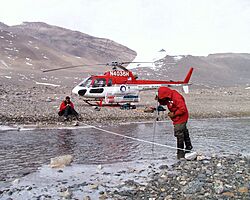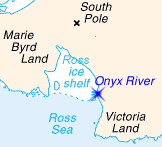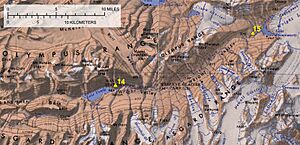Onyx River facts for kids
Quick facts for kids Onyx River |
|
|---|---|

Scientists take depth and velocity readings in the Onyx River (1999)
|
|
| Country | Antarctica |
| Physical characteristics | |
| Main source | Lake Brownworth 77°25′48″S 162°45′0″E / 77.43000°S 162.75000°E |
| River mouth | Lake Vanda 77°33′24″S 161°45′0″E / 77.55667°S 161.75000°E |
| Length | 32 km (20 mi) |
The Onyx River is a special river found in Antarctica. It's a meltwater stream, which means its water comes from melting ice and glaciers. This river flows west through the Wright Valley from the Wright Lower Glacier and Lake Brownworth. It ends its journey in Lake Vanda.
The Onyx River only flows for a few months during the Antarctic summer. It is about 32 kilometres (20 mi) long, making it the longest river in all of Antarctica!
Contents
What is the Onyx River?
The Onyx River is unique because it flows away from the ocean. This is called endorheic drainage. It happens because the Wright Lower Glacier blocks the valley's opening to the sea.
Where is This Unique River?
The river is located in the Wright Valley in Antarctica. It has several smaller streams, called tributaries, that feed into it. Along the river, there are many weather stations. These stations help scientists study the climate and conditions.
How Does the Onyx River Flow?
The amount of water flowing in the Onyx River changes a lot. It can vary throughout a single day and also from one summer to the next. Some years, the river might not even reach Lake Vanda.
However, in years with a lot of melting ice, the river can flood. These floods can cause a lot of erosion, which means the water wears away the land. In 1984, some researchers from New Zealand even went rafting on the river! At one point, the river's flow reached about 20 cubic meters per second.
Amazing Life in the Onyx River
Even though the Onyx River is in Antarctica, it's not completely empty of life. There are no fish in the river. However, it is home to many tiny living things that you can only see with a microscope.
Tiny Creatures and Algae
The river supports a lot of microscopic life. Sometimes, you can see large patches of algal blooms. These are big groups of tiny plant-like organisms. The main types of life here are cyanobacteria and other kinds of algae.
You can also find a few tiny micro-animals living in the river. These include nematodes (roundworms), tardigrades (also known as "water bears"), and rotifers. Occasionally, large birds called skuas visit the area.
Scientists Explore the Onyx River
The Onyx River is an important place for scientific research. It is studied by the United States Antarctic Program, which is part of the National Science Foundation. Scientists collect data to understand this unique environment.
Why Do Scientists Study the River?
Scientists have been collecting data on the river's water flow since 1969 near Lake Vanda. They started collecting data further upstream near the Wright Lower Glacier in 1972. The Antarctica New Zealand program also used to have a camp at Lake Vanda for research.
Since 1993, the McMurdo Long Term Ecological Research site has continued to keep records of the Onyx River. There is a small research shelter at the eastern end of Lake Vanda. Nearby, there is also a seismic station at Bull Pass. This station helps monitor for nuclear tests around the world.
How the River's Flow is Changing
Scientists have noticed something interesting from their long-term records. The Onyx River's flow season has started earlier and lasted longer over the years. This information helps scientists understand how the climate in Antarctica might be changing.
See also




